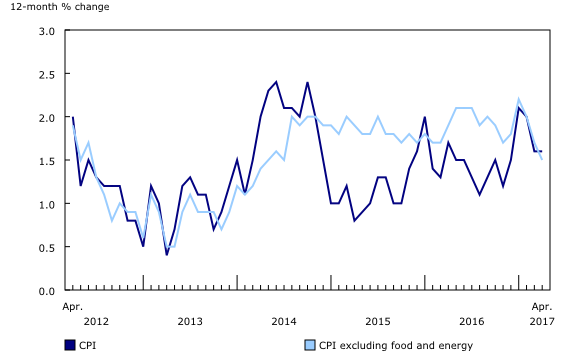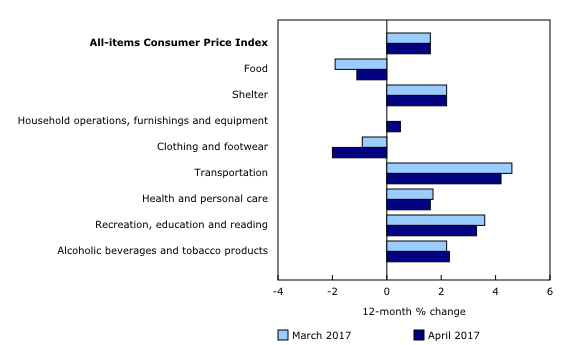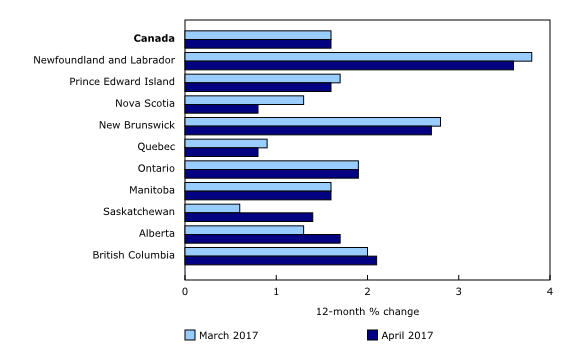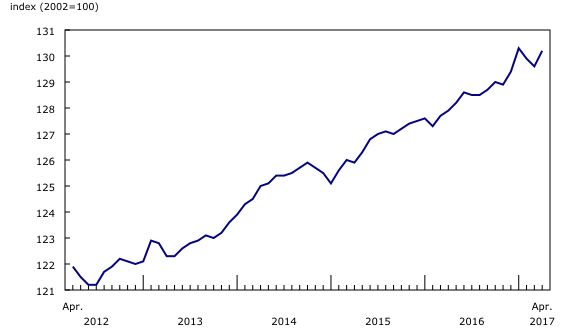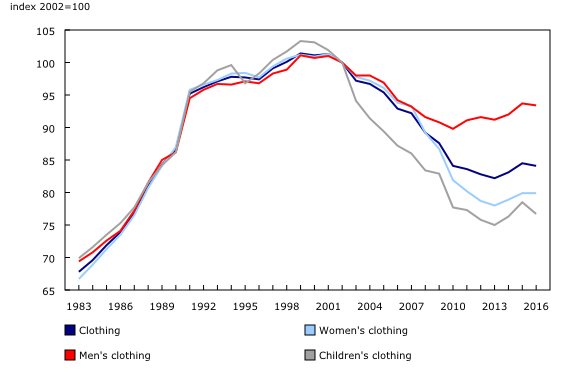Consumer Price Index, April 2017
Archived Content
Information identified as archived is provided for reference, research or recordkeeping purposes. It is not subject to the Government of Canada Web Standards and has not been altered or updated since it was archived. Please "contact us" to request a format other than those available.
Released: 2017-05-19
April 2017
1.6% 
(12-month change)
The Consumer Price Index (CPI) rose 1.6% on a year-over-year basis in April, matching the gain in March.
Overall, energy prices rose more year over year in April than they did in March, while declines in food prices moderated.
Excluding food and energy, the CPI was up 1.5% on a year-over-year basis in April, following a 1.7% increase in March.
12-month change in the major components
Prices were up in six of the eight major components in the 12 months to April, with the transportation and shelter indexes contributing the most to the year-over-year rise in the CPI. The food index declined on a year-over-year basis for the seventh consecutive month.
Transportation costs rose 4.2% over the 12-month period ending in April, after increasing 4.6% in March. This deceleration was led by the purchase of passenger vehicles index, which rose less on a year-over-year basis in April than in March. Gasoline prices posted a 15.9% year-over-year increase in April, slightly larger than the 15.2% rise registered in March. On a monthly basis, gasoline prices rose 9.5% in April, partly due to supply disruptions at oil refineries, as they changed over to summer fuel blends.
Shelter costs rose 2.2% in April on a year-over-year basis, matching the increases in February and March. The homeowners' replacement cost index (+3.9%) was the main upward contributor to the 12-month change in the shelter index, despite slowing growth since November 2016. Prices for natural gas (+15.2%) rose on a year-over-year basis for the fourth consecutive month. Conversely, electricity prices posted their fourth consecutive decline, down 1.3% year over year in April.
The recreation, education and reading index grew 3.3% in the 12 months to April, following a 3.6% increase in March. The travel tours index rose 9.4% year over year in April, contributing the most to the rise in the recreation, education and reading index. Traveller accommodation costs were up 5.7% year over year in April, after rising 1.4% in March. At the same time, the video equipment index fell 8.8% on a year-over-year basis in April. Prices for video and audio subscription services rose less in the year to April than in the 12-months to March.
The household operations, furnishings and equipment index rose 0.5% year over year in April, following no change in March. This acceleration was mainly attributable to a 3.8% month-over-month rise in the prices of telephone services, as new product introductions affected the price of service plans.
12-month change in the provinces
In five provinces, consumer prices rose less on a year-over-year basis in April than in March. The 12-month increase in the CPI was unchanged in two provinces in April from a month earlier, while it accelerated in Saskatchewan, Alberta and British Columbia.
In the Atlantic provinces, the gasoline index was the main contributor to the deceleration in the year-over-year change in consumer prices, due in part to smaller monthly increases this April compared with a year ago. At the national level, gasoline prices rose more on a year-over-year basis in April than in March.
Consumer prices in Ontario rose 1.9% in the 12 months to April, matching the gain in March. The homeowners' replacement cost index registered a 6.8% year-over-year increase in April, which was the largest gain among the provinces for the 10th consecutive month. Passenger vehicle insurance premiums were up 4.4% in the 12-month period ending in April, following a 3.5% increase in March. Among the provinces, Ontario registered the largest decline in men's clothing prices in the 12 months to April.
In Saskatchewan, an increase in the provincial sales tax, effective March 23, 2017, and an increase in its scope, effective April 1, 2017, both contributed to an acceleration in consumer price growth in the province. On a year-over-year basis, the CPI in Saskatchewan posted a 1.4% gain in April, after increasing 0.6% in March. Prices for food purchased from restaurants were up 7.3% year over year in April. Despite registering a 4.6% month-over-month increase, the telephone services index still declined 10.4% on a year-over-year basis in April.
In Nova Scotia, consumer prices rose 0.8% year over year in April, following a 1.3% gain in March. Among the provinces, Nova Scotia posted one of the largest declines in fresh vegetable prices in the 12 months to April. Passenger vehicle insurance premiums posted a 1.8% year-over-year decline in April; Nova Scotia was the sole province to record a decline in this index. Additionally, fuel oil prices were up 11.5% year over year in April, after posting a 15.0% gain in March.
Seasonally adjusted monthly Consumer Price Index
On a seasonally adjusted monthly basis, the CPI rose 0.5% in April after falling 0.2% in March.
Six major components increased on a seasonally adjusted monthly basis in April, with the transportation index (+1.3%) recording the largest increase. The clothing and footwear index declined 0.6%, while the recreation, education and reading index was unchanged.

In celebration of the country's 150th birthday, Statistics Canada is presenting snapshots from our rich statistical history.
The average Canadian household spent just over $3,300, or 4.3% of its total budget in scope of the Consumer Price Index, on clothing and accessories in 2015.
From 1983 to 2000, the cost of buying clothes rose almost 50%. In 1991 alone, clothing prices jumped by about 10%, with women's, men's and children's clothing all registering similar increases. Prior to 2000, most clothing purchased by Canadians was made in Canada or the United States.
In contrast, the new millennium coincided with the start of the longest continuous period of clothing price deflation. These deflationary effects in clothing were largely attributed to globalization and free trade. Prices for clothing fell significantly over this period due to the opening up of the Canadian market to lower-priced clothing made abroad. From 2000 to 2013, clothing prices fell by 19% overall; children's clothing declined 27%, while women's clothing decreased 23%. Men's clothing prices, on the other hand, declined by 9% over this same period.
More recently, clothing prices have stabilized, registering only modest growth over the past few years.
Note to readers
A seasonally adjusted series is one from which seasonal movements have been eliminated. Users employing Consumer Price Index (CPI) data for indexation purposes are advised to use the unadjusted indexes. For more information on seasonal adjustment, see Seasonally adjusted data – Frequently asked questions.
The special aggregate "energy" comprises electricity, natural gas, fuel oil and other fuels, gasoline, and fuel, parts and accessories for recreational vehicles.
Real-time CANSIM tables
Real-time CANSIM table 326-8023 will be updated on June 5. For more information, consult the document Real-time CANSIM tables.
Next release
The CPI for May will be released on June 23.
Products
The April 2017 issue of The Consumer Price Index, Vol. 96, no. 4 (62-001-X) is now available.
More information about the concepts and use of the Consumer Price Index (CPI) is available in The Canadian Consumer Price Index Reference Paper (62-553-X).
For information on the history of the CPI in Canada, consult the publication Exploring the First Century of Canada's Consumer Price Index (62-604-X).
Two videos, "An Overview of Canada's Consumer Price Index (CPI)" and "The Consumer Price Index and Your Experience of Price Change," are available on Statistics Canada's YouTube channel.
Contact information
For more information, or to enquire about the concepts, methods or data quality of this release, contact us (toll-free 1-800-263-1136; 514-283-8300; STATCAN.infostats-infostats.STATCAN@canada.ca) or Media Relations (613-951-4636; STATCAN.mediahotline-ligneinfomedias.STATCAN@canada.ca).
- Date modified:


